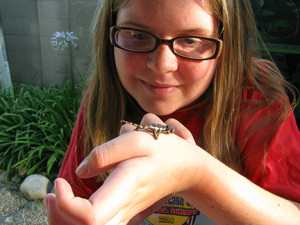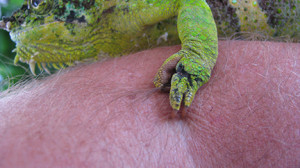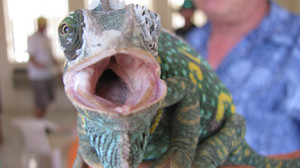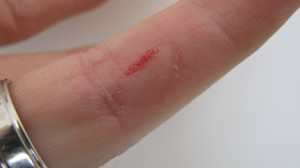Handling Your Chameleon:
Chameleons are tricky things to hold in that we don’t actually hold them, but allow them to sit on our hand. Today I will talk about handling your chameleon.
See the companion video with special guest Briana Kammer to demonstrate handling techniques!
Maintenance Handling vs. Recreational Handling with Chameleons
Today we are starting a three part series on handling your chameleon. This first episode will be simple extracting your chameleon from its cage and putting him back. Handling a chameleon has its nuances and it isn’t as obvious how to do it as one may think. The second episode is how to handle a chameleon that absolutely does not want to be held. Getting medicine shot down its throat, having its legs swabbed, or getting an injection does not rate high on any of our lists of things to do. The third part of the series will be on taming. Chameleons can be tamed at a basic level and this is a useful exercise for their acclimation to living with humans.
In a way, this series is a companion to episode 6 in which we talked about Stress. Once you are done listening here, your next step is to go back and listen to episode 6 either on your podcast player or at chameleonbreeder.com. There will be some overlap, but repetition is good!
Stress and the topic of handling are intertwined because handling is one of, admittedly, a number of stresses we place upon our chameleon. Now, there are two types of handling – maintenance handling and recreational handling. Maintenance handling is medicating, doing health inspections, vet visits, and extracting them when the cage needs a deep clean. Recreational handling is us playing with them, showing them off to friends, or doing any sort of taming training. Maintenance handling is necessary for health. Recreational handling is in that gray area. But either way, we need to know how to do it.
Basic thoughts on handling chameleons and stress
First, let’s address stress and handling. If you have been around just a bit you will have heard someone tell you that handling causes stress and stress will kill your sensitive chameleon. These are two truths that are sandwiched together, but there is so much that should be stuffed between those two ends. Because it is important to understand why I am going to fill in those blanks.
It pains me to say this, but chameleons are not designed to be pets. They have the very healthy and survival-encouraging assumption that anything bigger than them will eat them. That includes me and you. Chameleons do not understand the concept of love and affection so there is a huge mis-understanding between worlds as WE hold things we love close and THEM assuming that any closer means they will be eaten. Thus it is no wonder that handling your chameleon can be a source of stress for them.
Stress compromises our immune system. Humans, chameleons,.. we are the same in this. We, and chameleons, are always under attack by bacteria, viruses, funguses, and parasites just trying to make a living. It is our immune system that is constantly fighting these things off. Yes, things go poorly when we encounter a disease that is new to our body, but we also fall when we are weakened by not being warm enough, being too warm, not getting enough sleep, being under constant pressure from work or having constant relationship issues. It is when we are weakened these bugs that are all around us find that the defenses are not as strong as they should be. They get in and take hold.
But…and here is the filling in of the blanks…The stress that compromises our immune system is the constant stress. For chameleons it’s a parasite load or that other chameleon in the same cage that it can’t escape from. That is constant stress. Short periods of handling time is a stress spike. It will get their heart pumping, but handling is not a problem until you go past the acceptable level.
Now, at what point handling a chameleon becomes stressful depends greatly on the individual chameleon’s personality. There are some that think coming out of their cage is death and some that can’t wait to climb over their hairless ape. The problem is that until you understand chameleon body language you could be convinced that your chameleon is showing signs of affection when, in reality, it is at the end of it’s ability to cope. For example, we think a chameleon falling asleep in our hand is a sign of the ultimate trust. It is really the sign that the chameleon is so stressed that it has given up. This is a very dangerous miscommunication. As I want to get to handling techniques, please hop on over to episode 6 when you are done here. But what this means is that short handling periods – with all the caveats just described – are generally no problem against your chameleon’s health.
How to handle a chameleon
So now, let’s go over some basic handling techniques. To start with, most of the time we do not “hold” our chameleon. We do not entrap the chameleon in our hands. We allow it to perch on us. We allow them to freely range across our hand and arm. Holding them, meaning putting them in the palm of our hand and restricting their freedom, brings a high level of stress. Only in the most necessary times, such as administering medication should you ever hold a chameleon in your hand. We will start with a couple of basics.
The first is our energy level. When we are around our chameleon, especially at the beginning, we need to lower our energy level. Move slowly and calmly. Avoid quick movements and unnecessary arm waving. For all you expressive people that talk with your hands I am looking at you! The reason is that when presented with an animal bigger than they are a chameleon will naturally take on the prey attitude…well, most do. There are some that don’t realize how small they are, but most will be either scarred or at least wary of you. This will diminish as they get used to you and your mannerisms, but at the beginning, any quick movements will set off their internal alarms. It is the quick movement that is the hallmark of a predator and will trigger adrenaline surges and reflexive actions. You need to show you are not a predator. So be as calm and inexpressive as possible.
The second is our approach. A common predator strategy is coming at the chameleon from back and above. Think on how a hawk may come down on a chameleon. You being in this area puts your chameleon on high alert. This is the best way to get a fight or flight response. So, we are going to be careful how we enter that sensitive area.
The third is our strategy. In this episode, we will focus on encouraging the chameleon in making as many of its own choices as possible. When we talk about medicating we will have to be more direct, but, outside of medicating, any handling needs to be as stress free as possible. Encouraging choices that get him where we want him will be high on our list of tools.
For basic handling you place your finger or hand or whatever part of your arm is appropriate for the size of chameleon you are working with in front and below the chameleon. The ideal situation is that the chameleon climbs onto your hand under its own volition. Some chameleons who are totally acclimated to humans, or just have no fear, may need very little encouragement and will step onto the hand that is offered. By the number of people who say their chameleon does this on the internet you would think this is common. However, you are not hearing from the vast majority of keepers where this is not the case. Do not be disappointed if your chameleon does not seem to like you much or does not care so much for getting on your hand. This is actually normal. It is common for your chameleon to react with a look of “what do you want me to do with that?” which is followed by a slow chameleon turn to be somewhere else to leave you to work through your hand issues on your own. Otherwise, you could get the defense response of puffing up and even lunging to bite your hand. If it is a baby a common response is an all out panic run away or even a drop to the ground to get away. I know this hurts your feelings as you consider this your child that you will care for forever and ever. Just remember that millions of years have programmed that instinct inside your chameleon – especially baby chameleons – and it has worked well for eons. We are not going to reverse that any time soon. So it is nothing personal!
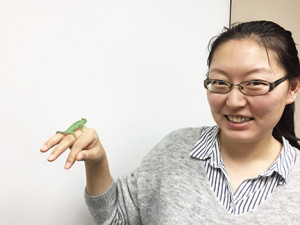
Almost every chameleon will need encouragement to step onto your hand. This can be done by bringing your other hand behind them and having them crawl onto your perching hand to get away from your herding hand. Once they find themselves on your perching hand it is too late and they’ll usually take a wait and see attitude.
Let’s talk about this “herding” hand. Remember how I talked about quick movements and above/behind being a bad relationship building experience? We are trying to herd them with annoyance and as little fear as possible. You can’t easily remove the fear component. It takes time. But you can avoid giving them quick shots of adrenaline and triggering the primordial fight/flight response. Move slowly and bring up your hand from behind. It doesn’t even have to be close to the chameleon. A sensitive chameleon will start walking away from your herding hand as soon as it is in the cage.
Once your chameleon is on your hand or arm just let your chameleon perch there. They may hike up your arm to try and get on top of your head. This is just a security measure for them. They like to be high up. In fact you will notice that the higher your perching hand is the calmer they are…well, unless they are trying to escape. In that case you’ll have a very active chameleon no matter what you do. Just put one hand in front of the other and you will be able to contain the escape plan. Although, and I hate to be a downer, be aware that the treadmill game is not your chameleon having fun. He is trying to escape and the road is unnaturally long.
A middle step is to use a branch instead of your perching hand. Just get a reasonable length branch and put that by your chameleon’s feet. Some of these clever creatures will treat your branch like they would your hand because they are pretty darn smart and they are not fooled by your big-brained mammalian bait and switch tricks. But a stick is often a much easier sell.
How to get a reluctant chameleon out of its cage
Now, let’s discuss the panicked or even aggressive chameleon. First, the panicked chameleon. There are chameleons that have a very high level of fear towards humans and being handled. You’ll often find this in wild caught chameleons or in babies. Wild Caught chameleons, unsurprisingly, have a much higher fear of humans than the ones brought up being fed by their human servants all their life. But it can happen with any individual of any species from anywhere. This panic can even manifest itself by your chameleon leaping into the air to get away from you. They are willing to take their chances with an injury from a fall rather than the almost sure death that comes from when you put them in your mouth. Remember, their survival instinct was not developed with your loving heart in mind. Trioceros quadricornis and montium can even roll into a tight disc as they launch themselves in the air to get a little gliding distance going. It is pretty easy to pick them up from the bottom of the cage after this, but you will not be able to trust that they will stay perched on your hand and if they attempt to jump off your hand you know you have a chameleon with a strong survival instinct. You’ll want to be extremely careful not to trust that they will just perch on your hand. They actually will watch for when you look away and then leap into oblivion. Chameleons can survive falls surprisingly well, but it is absolutely a trauma you want to avoid. When they do this they are not checking to make sure they do not hit anything along the way. If they hit the corner of a hard surface this jump and fall could be fatal. Unfortunately, this kind of chameleon needs to be held in the traditional sense of the word. This is a bad situation because a jumper is already high strung. Entrapping him in your hand will be many times more stressful for him. This particular chameleon is not a good candidate for holding and holding should be done only for the most necessary maintenance and medication purposes. You are in more luck when it comes to babies because they can grow out of it. Once they get some size to them their confidence will increased. If your baby is panicked don’t chase him around the cage. That just adds to the panic and engrains a fear of you. You will just have to be patient and try to get him to climb on a stick you provide. And, yes, he will do his darndest to get off that stick before you can pull it out. This is where the patience comes in. But truly consider why you are bringing him out. Is it necessary? You can always try again tomorrow if it is not critical. Both babies and adults can be tamed down over time. Hang tight for the upcoming taming episode for that.
Chameleon Claws and Skin Rash
There are some consequences for holding your chameleon. A chameleon’s feet are meant to be strong enough for holding onto branches at the top of a tree with the wind blowing. The claws are designed to dig into branch to allow vertical climbing. These feet are wonderfully designed to grab tree parts. Our hands, fingers, and arms are much more sensitive than tree parts and our skin is not bark. Thus it is common for you to find small scratches and punctures all over your hands after putting your chameleon back. The smaller chameleons are less of a problem. An adult veiled or panther chameleon has the strength to make you notice big time. A Parson’s chameleon can stop you in your tracks as you try desperately to figure out how to get his vice-like clawed grip off your poor finger. You already have the punctures of his claws into your skin. You are just hoping you can provide him with an attractive perching branch so he moves on his own. If you try and dislodge him he tightens his grip. If you try to pull him off you just turned punctures into deep gouges! Handling a large chameleon is really a collaboration. You can wear gloves if you want, but the added shape may intimidate your chameleon and remember they are great at seeing colors. There may or may not be issues with the gloves being on sometimes and not others. As with every part of husbandry – keep observing your chameleon and adjust as is appropriate.
Being Bit by a Chameleon
Let’s turn our attention towards biting. The big question everyone asks when considering a new pet. “Will it bite” and then the pet store employee who thinks himself much more clever than he actually is will say “every animal bites”. If this happens, just stare at him until he answers what he knows you meant. If he doesn’t answer your question then why in the world aren’t you buying a chameleon from a breeder in the community? ….Well, I suppose we can just answer this here and you won’t have to play that game. Yes, chameleons can bite. They have true teeth and they have a jaw strong enough to crunch beetles. And, yes, these teeth can draw blood on a hapless human.
Now, the fact is that bites are rare. Chameleons do not hide their emotions. They do not lie in wait. They are very expressive and bites come after some pretty obvious warnings that it is coming. Chameleon bites are a surprise only for the densest among us. You don’t even have to speak the subtle nuances of chameleon body language. They use an effective blend of showing their teeth and even lunging at you to get the point across. If you do not get the message after that then the natural order of things is that you have a learning experience just waiting to meet your acquaintance.
That said, an adult male panther or veiled can give you a respectable bite. Usually it is a bite and release with the intention of escape. Only rarely is it a bite intended to do damage. And, yes, I have had a few foul tempered chameleons that wanted to do damage. They do exist, but they are rare. Most chameleon keepers go through their entire 5 to 7 years of pet chameleon ownership never experiencing a bite. Especially if you get a captive bred chameleon you are on the easy road. Those of us who work with wild caught get to experience a little more excitement. The, uh, kind of excitement that you don’t necessarily need in your life.
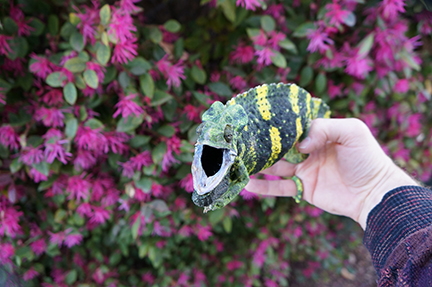
Playing with your Chameleon.
Though there is another side to this. Many chameleons are so passive it causes another problem. And that is that some keepers want to play with their chameleon. Jackson’s chameleons are the species that most often end up having their passiveness be misinterpreted as a desire to play or be with humans. People read into the passive nature that the chameleon not only tolerates it, but actually loves play time! Chameleons do not play. Go ahead and bring your chameleon out for brief periods of time to quietly observe him. There is immense value in you getting up close and personal with your chameleon in the way that this is how we humans build value and relationship with something. And if enough people value chameleons then perhaps we can put in the efforts to reverse our destructive environmental actions. Honestly, how many of us can point to Madagascar on a map only because we got into chameleons? Share your experience with your friends. And that can include short periods of time out of the cage to show your friends. But please, no soap bubble popping. And especially no playtime with your other pets. If you want to interact with your chameleon do chameleon things, not human things. Here are some things to do with your chameleon:
- Put them on a tree branch and watch them crawl around getting unfiltered natural sunlight.
- Feed them special treats of green and/or flying insects
- Observe them and enjoy studying their behavior
So I say a short period of time for holding. The reality is that each chameleon will tolerate different lengths of handling time. This is where we come back to knowing your chameleon and knowing chameleon body language.
Lifting your Chameleon by its tail
When bringing your chameleon out to share the experience with friends you’ll want to be careful for your friend’s reactions to a lizard. A surprising number of people are nervous around reptiles. A jerking of their hand when you are in mid transfer or a panicked flinging of the chameleon as it makes its way up their arm can deal serious damage to your pet. The world needs more chameleon evangelists, but do not be so excited to share your new found love that you pressure people into holding your chameleon before they are mentally ready. Many of you are shaking your heads asking how anyone could be scared of a chameleon. Wouldn’t the possibility of having your own dragon perched on your shoulder overcome any fear? Yeah, so don’t ask me to explain these poor souls. Just know they are many and the safety of your chameleon is your top priority.
While you might think that handing a nervous friend a branch with the chameleon on it may be a good compromise this may back fire as your wonderfully acclimated chameleon may then run towards your friend’s hand with the intention of making it to the top of friend mountain. A prehistoric looking dinosaur suddenly charging towards your friend’s face may produce an unintended response opposite of what you were hoping. You know how you feel when a strange dog escapes their leash and is charging at full speed towards you and your dog? The owner is yelling not to worry because his dog doesn’t bite. All nice and good, but your fight or flight center of your brain is going off the charts. Maybe this dog doesn’t bite the hand that feeds it, but you and your smaller dog are not convinced that protection extends to you two.
Once you have determined that your friend is safe for chameleon holding just use the same method as getting the chameleon out of its cage. Put your friend’s hand under and in front of the chameleon and encourage your chameleon to walk forward. Make sure your friend knows to stay put until all five grabby parts have released you. That is four feet and a tail. All need to be free before the receiving hand can move away.
An interesting a fun way of transferring a chameleon is through his tail. Many chameleons such as panthers, veileds, and jacksons have strong prehensile tails. These tails naturally wrap around things to provide anchor points. The tail actually overrides the feet in priority. So, with just a basic level of comfort with you, you can transfer these chameleons from your hand to somewhere else by getting them to wrap their tail around your finger. Rub your finger along the underside of the tail until it wraps tightly around your finger. You can then slowly lift off and your chameleon will go where its tail goes. You can then place the chameleon on your friend’s hand or else back in its cage.
Back in the Chameleon cage
And just to reiterate moving a chameleon from one spot to another – whether that is a friend’s hand or back into the cage. You must provide the same care on the back end that we did getting him out of the cage in the first place. Just like when your chameleon started stepping onto your hand, he may cautiously step off your hand. This means you must be patient until all five gripping parts are away before you draw your hand back. If you have a nervous chameleon it may just short of leap into its cage to get away. A more acclimated chameleon has a tendency to move slowly. Sometimes painfully slowly as you have to go to work and they sit half on their cage branch and half on your hand just watching you. Use your “herding” hand or gently tap their backside to encourage them to continue moving forward.
Next Steps
So these are handling basics. There are a couple of other aspects I would like to address coming up. The next episode will be on the challenging situation of handling a chameleon you are attempting to medicate. Everything I said about the chameleon not really wanting to bite you kind of goes out the window when you are swabbing at sensitive areas. And then we will wrap it up with a talk on taming your chameleon. And, no, I am not talking about “best buddy for life” training. My job here is to get you and your chameleon on a good enough standing that basic care and maintenance is a comfortable interaction between you and your mini-tree dragon. Though, you know, a little tongue zap on demand wouldn’t hurt anyone so I’ll include that!
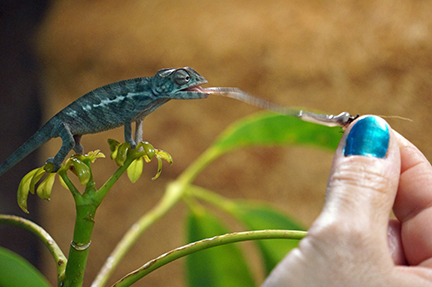
Until we meet again, keep hungry for growth. Our knowledge about these modern day dragons is certainly respectable, but nowhere near complete. If you want to know more then just stick around. This podcast is not so much a vehicle for me sharing my wisdom. It is me welcoming you to come along with my journey to know the world of chameleons better. So climb aboard and let’s see what we can discover!

